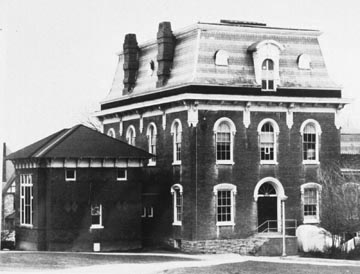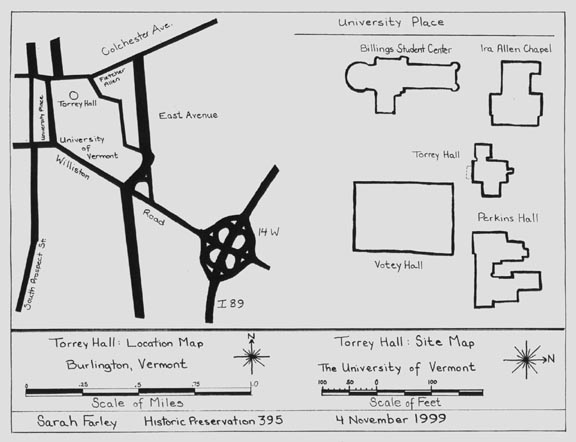
Fig. 1 An early photo of Torrey Hall
The history of Torrey Hall is one that spans more than 130 years. In that time the building has served the University of Vermont as its first library, as a museum, and as a meeting place for classes. It has relinquished its location on the University green and been left to rest on a more obscure site. And, it has survived several additions as well as a major renovation. Despite the fact that Torrey Hall is no longer in a position of prominence on the campus, its history is colorful and is worthy of investigation.
In a large part, Torrey Hall owes its existence to Joseph Torrey, who served the University as a professor and as its ninth president. In its early days, business and education at the University of Vermont were conducted in one main building. Consequently, it was here, too, that the University's literary holdings remained. However, in 1824 fire consumed this building and all but 125 of the books in the University's collection.1
After funds were allotted for the replacement of the books, Joseph Torrey, then a professor of philosophy, was tapped by the administrators to travel to Europe with the goal of purchasing much needed books for the University. Professor Torrey made his voyage in 1835 and returned to Vermont with 7000 volumes.2 In 1862 a new library was built and named in his honor; Torrey Hall remained the library until the completion of the Billings Library in 1885.
Due to its importance as a library, as well as the University's second major liberal arts building, Torrey Hall originally occupied a prominent location on the University green.3 However, the University continued to expand and in 1895 Torrey Hall was relocated in an effort to create space for the construction of Williams Hall.4 Today, the building rests nestled between Billings Center and Votey Hall.
Over time, the size and shape of Torrey Hall evolved
as well. Originally constructed with a wood frame and clad in brick,
Torrey Hall stood two stories tall and covered an area of 2400 square feet.5
In 1873, the third story and mansard roof were added and the building became
home to the Park Gallery of Arts. Circa 1898, a gentleman by the
name of Henry LeGrand Cannon funded the addition of a two-story wing to
the east side of the building; just a year later he added a single-story
west wing to house the art collection he bequeathed to the University.6
Following the construction of the Fleming Museum in 1931, the Engineering
College assumed the use of Torrey Hall. In 1942 the building became
a studio art center and was used for photography instruction, print making
and art education classes until 1973.

Fig. 1 An early photo of Torrey Hall
After nearly a century of serving the University of Vermont, Torrey Hall underwent major renovations in 1974 (Fig. 1). The firm of Wiemann- Lamphere Architects, Burlington, designed the plans for the revisions.7 Originally, a small flight of stairs on the south façade provided the only entrance to the building and a single central staircase connected the three stories. In addition, a plan of the original structure (as illustrated by Wiemann and Lamphere and submitted with the renovation plans) shows that the building's rooms were very small and that the staircase consumed a considerable amount of space.
The work on Torrey Hall resulted in new heating, power and lighting systems, new floor plans for each story and significant exterior modifications. Following the renovations, an elevator provided access to all floors and the central staircase occupied considerably less space. In addition, asphalt shingles replaced the slate which previously covered the roofs, a fire escape was removed from the north façade, a chimney was removed from the north elevation of the east wing, the single flight of stairs on the south façade was enlarged and concealed behind a brick wall and the roof edge on the main block was extended.8 Additionally, the design plans show that a ramp was to cover the approach to the entrance of the building; however, if the ramp was added, it no longer remains a feature of the structure. These extensive modifications resulted in a modern academic building designed for ease of use and economy of space. Following renovation, the Pringle Herbarium was moved into Torrey Hall where it remains today. Presently, the building is home to two classrooms as well as the Thompson Natural History Collection and the Churchill Library (Fig. 2).

Fig. 2 Torrey Hall in its present location, post-renovations
(Author photo, 1999)
While no longer a prominent feature of the University of Vermont campus, Torrey Hall continues to serve the academic community. The care with which the University has maintained the building is a testament to its historical significance. Additionally, its presence among many grand and modern buildings causes it to stand out and insures that while the evolution of the University of Vermont campus continues, its roots will not be forgotten.

Fig. 3: Torrey Hall Location Map and Site Plan
Sources
1 Jeffrey D. Marshall, Universitas Viridis Montis: an Exhibition of Documents and Artifacts Telling the Story of the University of Vermont 1791- 1991, University of Vermont Special Collections, Burlington, 1991, 28.
3 "Old Art Building," National Register Nomination, 1973, 3.
7 Wiemann and Lamphere, Plans for the Renovation of
the Old Art Building (Torrey Hall), University of Vermont Land Records
Office, Burlington, 1974.
Photo Credits
Fig. 1: Frank Smallwood, The University of Vermont Presidents:
Two Centuries of Leadership, University of Vermont, Burlington, 1997,
29.
Fig. 2: Photo by author, 1999.
Fig. 3: Site Plan and Location Map illustrated by author,
1999.
Torrey Hall: Timeline
Date: Event:
1824 Fire destroys all but 125 volumes of UVM's holdings
1835 Joseph Torrey travels to Europe for books and returns with 7000 volumes
1836 Joseph Torrey appointed librarian
1862 Joseph Torrey
becomes UVM's 9th president
Torrey Hall constructed
1866 Joseph Torrey resigns as president
1873 Third story and mansard roof added to Torrey Hall
1885 Billings Library completed
1895 Torrey Hall moved from University green to make room for Williams Hall
1898 Wing added to east façade
1899 Wing added to west façade
1931 Fleming Museum constructed
1942 Torrey Hall becomes a studio arts center
1974 Major renovation of Torrey Hall
1975 Pringle Herbarium moves into Torrey Hall
1999 Torrey Hall used
as academic building